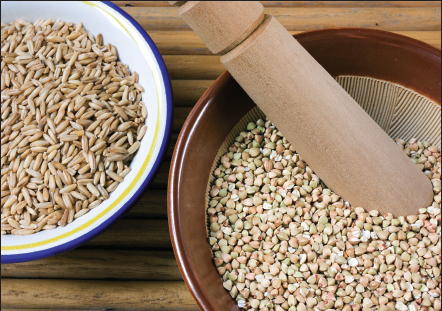
Grains are a type of grass and they grow almost as easily as the grass in your yard does. There are many reasons for growing your own grains, including supplying feed for your livestock, providing food for you and your family, or to use as a green manure (a crop that will be plowed back into the soil to enrich it). Growing grains requires much less work than growing a vegetable garden, though getting the grains from the field to the table requires a bit more work.
Whether you are growing wheat, oats, barley, or another grain, the process is basically the same:
1. Decide which grain to grow. Most cereal grains have a spring variety and a winter variety. Winter grains are often preferred because they are more nutritious than spring varieties and are less affected by weeds in the spring. However, spring wheat is preferred in cold climates as winter wheat may not survive very harsh winters. If you have trouble finding smaller amounts of seeds to purchase from seed supply houses, try health food stores. They often have bins full of grains you can buy in bulk for eating, and they work just as well for planting, as long as you know what variety of grain you’re buying. Winter grains should be planted from late September to mid-October, after most insects have disappeared but before the hard frosts set in. Spring wheat should be planted in early spring.

2. Decide how much grain you want to grow. A 10-foot by 10-foot plot of wheat will provide enough flour for about twenty loaves of bread. An acre of corn will provide feed for a pig, a milk cow, a beef steer, and thirty laying hens for an entire year.
3. Prepare the soil. Rototill or use a shovel to turn over the earth, remove any stones or weeds, and make the plot as even as possible using a garden rake.
4. Sprinkle the seeds over the entire plot. How much seed you use will depend on the grain (refer to the chart on page 32). For wheat, use a ratio of around 3 ounces of seed per 100 square feet. Aim to plant about one seed per square inch. Rake over the plot to cover all the seeds with earth.
5. Water the seeds immediately after planting and then about once a month throughout the growing season if there’s not adequate rainfall.
6. When the grain is golden with a few streaks of green left, it’s ready for harvest. For winter grains, harvest is usually ready in June or July. To cut the grains, use a scythe, machete, or other sharp knife, and cut near the base of the stems. Gather the grains into bundles, tie them with twine, and stand them upright in the plot to finish ripening. Lean three or four bundles together to keep them from falling over. If there is danger of rain, move the sheaves into a barn or other covered area to prevent them from molding. Once all the green has turned to gold, the grains are ready for threshing.

7. The simplest way to thresh is to grasp a bunch of stalks and beat it around the inside of a barrel, heads facing down. The grain will fall right off the stalks. Alternatively, you can lay the stalks down on a hard surface covered by an old sheet and beat the seed heads with a broom or baseball bat. Discard (or compost) the stalks. If there is enough breeze, the chaff will blow away, leaving only the grains. You can also pour the grain and chaff back and forth between two barrels and allow the wind (which can be supplied by a fan if necessary) to blow away the chaff.
8. Store grain in a covered metal trash can or a wooden bin. Be sure it is kept completely dry and that no rodents can get in.
HOW MUCH GRAIN SHOULD YOU GROW TO FEED YOUR FAMILY?
An acre of wheat will supply about 30 bushels of grain, or around 1,800 pounds. The average American consumes about 140 pounds of wheat in a year. The Federal Emergency Management Association (FEMA) recommends the following consumption rates:
• Adult males, pregnant or nursing mothers, active teens ages 14 to 18: 275 lbs./year
• Women, kids ages 7 to 13, seniors: 175 lbs./year
• Children 6 and under: 60 lbs./year
GRAIN GROWING CHART

